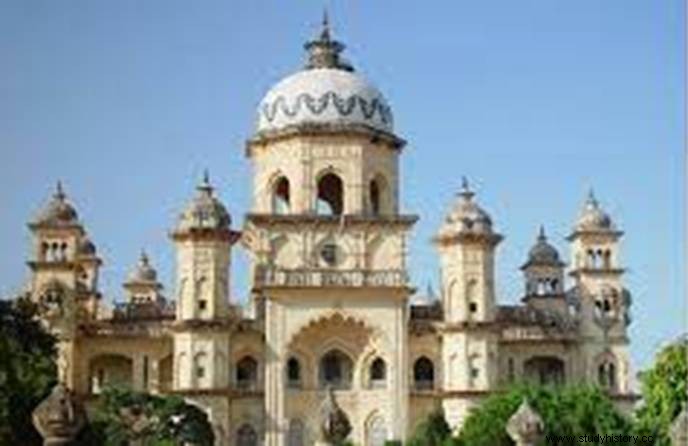
The art of buildings built in India by Muslim rulers during the Delhi Sultanate period is called Muslim art, Ottoman architecture and Indo-Saracenic architecture. This art was not only different from the ancient Hindu architecture and medieval Rajput architecture prevalent in India, but also different from the Mughal architecture that was established after the Turks.
Three Phases of Muslim Vastu
The three successive stages of Muslim Vastu are clear-
(1.) Step 1: The first phase was to destroy Hindu architecture inspired by the conquest and fanaticism of the conquering invaders. Hasan Nizami, who came to India with Muhammad Ghori, has written that after each fort was conquered, its pillars and foundations were trampled under the feet of giant elephants and crushed to dust. Many Indian cities, forts and temples were destroyed in this way.
(2.) Step 2: The second phase was of purposeful and partial demolition in which Hindu buildings were demolished to provide ready-made materials for the mosques and tombs of the conquerors. Large dharnas and pillars were taken out of temples and other Hindu buildings and taken to new places. During this period, the temples suffered special damage, which were used as mines of ready-made materials for the construction of new capitals of the provinces conquered by the Muslims, and Hindu architecture from North India was almost completely destroyed.
(3.) Step 3: The third and final phase of Muslim Vastu started when Muslim invaders started building mosques and mausoleums in many parts of the country.
Three Styles of Muslim Architecture
Muslim architectural styles can be classified into three categories-
(1.) Delhi Architectural Style (E.1193-1554): It is also called Pathan style and Shahenshahi style. This style was followed by the Turkish Sultans from Central Asia and the Pathan Sultans from Afghanistan during the Delhi Sultanate. Delhi's Qutub Minar (E.1200), Sultan Garhi (E.1231), Altamash's Tomb (E.1236), Alai Darwaza (E.1305), Nizamuddin (E.1320), Ghiyasuddin Tughlaq (E.1325) in this style ) and Tomb of Firoz Shah Tughlaq (AD.1388), Kotla Firoz Shah (AD.1354-1490), Tomb of Mubarak Shah (AD.1434), Mosque of Meerut (AD.1505), Mosque of Sher Shah (AD.1540-45) Sher Shah's tomb of Sahasram (AD.1540-45) and Adhai Din ka Jhonpra of Ajmer (AD.1205) etc. are noteworthy.
(2.) Provincial Architectural Styles: The following styles can be placed in the medieval provincial Muslim styles-
Punjab Style (E.1150-1325) : The tombs of Shah Yusuf Gardiji (E.1150), Tabrizhi (E.1276), Baha'ulhaq (E.1262) Multan's Shrakne Alam (E.1320) are prominent in this style.
Bengal Style (1203-1573) : The Adina Mosque of Pandua (AD.1364), the Tomb of Fateh Khan of Gour (AD.1657), Kadam Rasool (AD.1530) and the Tantimara Mosque (AD.1475) are prominent in this style.
Gujarat Style (E.1300-1572) : The prominent ones in this style are the Jama Masjids of Cambay (E.1325), Ahmedabad (E.1423), Bharaunch and Chamane (E.1523) and Nagina Masjid (E.1525).
Jaunpur Style (E.1376-1479) : Atala Masjid (E.1408), Lal Darwaza Masjid (E.1450) and Jama Masjid (E.1470) of Jaunpur are prominent in this style.
Malwa Style (1405-1569) : Mandu's Jahaz-Mahal (E.1460), Hoshang's Tomb (E.1440), Jama Masjid (E.1440), Hindola Mahal (E.1425), Dhar Ki Laat Masjid (E.1405), Chanderi Ka Badal Mahal Gate (E.1460), Kushak Mahal (E.1445), Shehzadi Ka Rauja (E.1450) etc. are prominent.
Southern Style (1347-1617) : In this style, Jama Masjid of Gulbarga (E.1367) and Haft Gumbaz (E.1378), Madrasa of Bidar (E.1481), Charminar of Hyderabad (E.1591) etc. are prominent.
Bijapur Khandesh Style (1425-1660) : In this style, Golgumbaz (AD.1660) of Bijapur, Rauza Ibrahim (AD.1615) and Jama Masjid (AD.1570), tombs of Faruqi dynasty of Thalner Khandesh (15th century) etc. are prominent.
Kashmir style (15-17th century) : This style includes the Jama Masjid of Srinagar (1400), the tomb of Shah Hamdan (17th century), etc.
(3.) Mughal architectural style : In the third category comes the Mughal style, the best examples of which are located in Delhi, Agra, Fatehpur Sikri, Lucknow, Lahore, Allahabad, Aurangabad etc. in the form of forts, tombs, mosques, palaces, garden-pavilions etc. During this period, architecture progressed from red-sandstone to marble and world famous buildings like Delhi's Deewane Khas, Moti Masjid, Jama Masjid and Agra's Taj Mahal were built.
Reasons for the syncretism of Hindu-Muslim styles
Indo-Saracenic architecture developed due to the synthesis of Hindu-Muslim styles. The process of synchronizing Hindu-Muslim styles took place very fast, due to some special reasons-
(1.) When the Muslim rulers started building palaces, mosques and tombs in India, they did not get the craftsmen of Muslim architecture in India. Therefore some craftsmen were called from places like Persia etc. Indian craftsmen worked under his direction. Therefore, it was only natural that elements of Hindu architecture should be included in Muslim architecture.
(2.) Muslims spread very fast in different areas of India, due to which they needed a large number of palaces, mosques and tombs etc. The construction of these buildings required a lot of material, which could not be fulfilled quickly, due to which the ornamentation of many Hindu buildings was destroyed and their original construction was converted into Islamic style. The impressions of Hindu and Muslim styles are visible in those buildings.
(3.) For many Muslim renovations, old Hindu temples, palaces etc. were demolished and their materials were used. Due to this also the influence of Hindu style on Muslim style was visible.
